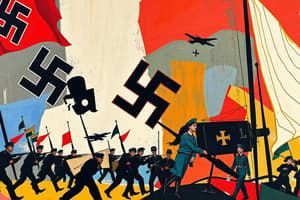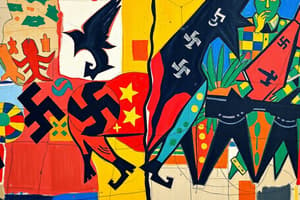Podcast
Questions and Answers
Which of the following was NOT a major Axis power during World War II?
Which of the following was NOT a major Axis power during World War II?
- Germany
- Japan
- France (correct)
- Italy
The Treaty of Versailles, which ended World War I, helped create conditions that led to World War II.
The Treaty of Versailles, which ended World War I, helped create conditions that led to World War II.
True (A)
What event is generally considered the start of World War II in Europe?
What event is generally considered the start of World War II in Europe?
Invasion of Poland
The German aerial campaign against Britain in 1940 was known as the Battle of _______.
The German aerial campaign against Britain in 1940 was known as the Battle of _______.
Match the following events with their corresponding year:
Match the following events with their corresponding year:
What was the name of the German invasion of the Soviet Union in 1941?
What was the name of the German invasion of the Soviet Union in 1941?
The Battle of Stalingrad was a decisive victory for the German army on the Eastern Front.
The Battle of Stalingrad was a decisive victory for the German army on the Eastern Front.
What was the main objective of the Allied D-Day invasion of Normandy in 1944?
What was the main objective of the Allied D-Day invasion of Normandy in 1944?
The United States dropped atomic bombs on the Japanese cities of Hiroshima and _______.
The United States dropped atomic bombs on the Japanese cities of Hiroshima and _______.
Match the following military theaters with their respective geographic locations:
Match the following military theaters with their respective geographic locations:
Which of the following was a key technological advancement during World War II used for detecting enemy aircraft?
Which of the following was a key technological advancement during World War II used for detecting enemy aircraft?
The Manhattan Project was a German initiative to develop atomic weapons.
The Manhattan Project was a German initiative to develop atomic weapons.
What international organization was established in 1945 to promote international cooperation and prevent future conflicts?
What international organization was established in 1945 to promote international cooperation and prevent future conflicts?
The systematic persecution and murder of six million Jews by the Nazi regime is known as the _______.
The systematic persecution and murder of six million Jews by the Nazi regime is known as the _______.
Match the following Nazi concentration camps with their primary purpose:
Match the following Nazi concentration camps with their primary purpose:
What was the policy of appeasement adopted by Britain and France towards Germany?
What was the policy of appeasement adopted by Britain and France towards Germany?
The rise of fascism in Italy and Nazism in Germany promoted international cooperation and peace.
The rise of fascism in Italy and Nazism in Germany promoted international cooperation and peace.
Which country's expansionism in Asia, particularly its invasion of Manchuria, heightened tensions in the Pacific before World War II?
Which country's expansionism in Asia, particularly its invasion of Manchuria, heightened tensions in the Pacific before World War II?
The Battle of the _______ was Germany's last major offensive on the Western Front, aimed at splitting the Allied forces.
The Battle of the _______ was Germany's last major offensive on the Western Front, aimed at splitting the Allied forces.
Match the following individuals to their roles during World War II:
Match the following individuals to their roles during World War II:
Flashcards
World War II
World War II
Global conflict from 1939 to 1945 involving the Allies and Axis.
Major Axis Powers
Major Axis Powers
Germany, Italy, and Japan.
Major Allied Powers
Major Allied Powers
Great Britain, the United States, and the Soviet Union.
Treaty of Versailles
Treaty of Versailles
Signup and view all the flashcards
Appeasement
Appeasement
Signup and view all the flashcards
Invasion of Poland (1939)
Invasion of Poland (1939)
Signup and view all the flashcards
Pearl Harbor (1941)
Pearl Harbor (1941)
Signup and view all the flashcards
D-Day (1944)
D-Day (1944)
Signup and view all the flashcards
The Holocaust
The Holocaust
Signup and view all the flashcards
The Manhattan Project
The Manhattan Project
Signup and view all the flashcards
Radar
Radar
Signup and view all the flashcards
United Nations
United Nations
Signup and view all the flashcards
Study Notes
- World War II was a global conflict that lasted from 1939 to 1945.
- It involved the vast majority of the world's countries, forming two opposing military alliances: the Allies and the Axis.
- It was the most widespread war in history, directly involving more than 100 million people from more than 30 countries.
- The major Axis powers were Germany, Italy, and Japan.
- The major Allied powers were Great Britain, the United States, and the Soviet Union.
Causes of World War II
- The Treaty of Versailles, which ended World War I, imposed harsh terms on Germany, leading to resentment and instability.
- The rise of aggressive ideologies such as fascism in Italy and Nazism in Germany created an environment of expansionism and militarism.
- The failure of the League of Nations to maintain peace and resolve international disputes contributed to the escalating tensions.
- Economic depression in the 1930s led to social unrest and political radicalization in many countries.
- Japanese expansionism in Asia, particularly its invasion of Manchuria in 1931 and its aggression towards China, heightened tensions in the Pacific.
- Appeasement: The policy of appeasement, adopted by Britain and France towards Germany's aggressive actions, emboldened Hitler and allowed Germany to rearm and expand its territory.
Key Events
- Invasion of Poland (1939): Germany's invasion of Poland on September 1, 1939, triggered declarations of war by France and the United Kingdom, marking the start of World War II.
- Fall of France (1940): Germany's swift invasion and conquest of France in May-June 1940 resulted in the establishment of a collaborationist Vichy regime.
- Battle of Britain (1940): The German Luftwaffe's aerial campaign against Britain aimed to weaken its defenses in preparation for a potential invasion, but the Royal Air Force (RAF) successfully defended British airspace.
- Operation Barbarossa (1941): Germany's invasion of the Soviet Union in June 1941, a massive military operation, aimed to conquer Soviet territory and resources, but it ultimately failed.
- Pearl Harbor (1941): Japan's surprise attack on the US naval base at Pearl Harbor on December 7, 1941, led to the United States declaring war on Japan and entering World War II.
- Battle of Stalingrad (1942-1943): A turning point on the Eastern Front, the Battle of Stalingrad saw Soviet forces defeat the German army in a brutal and costly urban battle.
- D-Day (1944): The Allied invasion of Normandy on June 6, 1944, marked the beginning of the liberation of Western Europe from Nazi occupation.
- Battle of the Bulge (1944-1945): Germany's last major offensive on the Western Front, aimed at splitting the Allied forces, was ultimately repelled.
- Atomic bombings of Hiroshima and Nagasaki (1945): The United States dropped atomic bombs on the Japanese cities of Hiroshima and Nagasaki in August 1945, leading to Japan's surrender and the end of World War II.
Key Military Theaters
- European Theater:
- This theater encompassed battles fought in Europe and North Africa.
- Major campaigns included the Battle of Britain, the Eastern Front (German-Soviet conflict), the North African campaign, and the invasion of Italy.
- The Allied invasion of Normandy (D-Day) in 1944 opened a second front in Western Europe, leading to the liberation of France and the eventual defeat of Germany.
- Pacific Theater:
- The Pacific Theater involved battles fought in the Pacific Ocean and East Asia.
- Key events included the attack on Pearl Harbor, the Battle of Midway, the island-hopping campaign by the United States, and the battles of Guadalcanal and Okinawa.
- The use of atomic bombs on Hiroshima and Nagasaki led to Japan's surrender.
The Holocaust
- The Holocaust was the systematic, state-sponsored persecution and murder of six million Jews by the Nazi regime and its collaborators.
- Jews were targeted for discrimination, exclusion, and eventual extermination based on racial ideology.
- Other groups, including Roma, homosexuals, disabled people, and political opponents, were also persecuted.
- Concentration camps and extermination camps were established to carry out the mass murder of Jews and other victims.
- Auschwitz-Birkenau was the largest extermination camp, where approximately 1.1 million people were murdered.
Technological Advancements
- Radar was developed and used extensively by both sides for detecting enemy aircraft and ships.
- Advances in aircraft design led to the development of faster and more maneuverable fighters and bombers.
- The development of the atomic bomb by the Manhattan Project had a profound impact on the outcome of the war and the course of history.
- Improved tanks, artillery, and other armored vehicles played a crucial role in ground warfare.
- Advances in submarine technology led to the development of more effective U-boats by Germany.
- Cryptography and code-breaking became increasingly important, with the Allies successfully breaking German codes through efforts like the Enigma project.
Consequences of World War II
- The war resulted in an estimated 50 to 85 million fatalities, making it the deadliest conflict in human history.
- The war caused widespread destruction and displacement, particularly in Europe and Asia.
- The United Nations was established in 1945 to promote international cooperation and prevent future conflicts.
- The war led to the emergence of the United States and the Soviet Union as superpowers, setting the stage for the Cold War.
- The war accelerated decolonization, as European powers were weakened and nationalist movements gained momentum in their colonies.
- The war led to significant social and economic changes, including increased opportunities for women and minorities.
- The Nuremberg trials were held to prosecute Nazi leaders for war crimes and crimes against humanity, establishing important principles of international law.
Studying That Suits You
Use AI to generate personalized quizzes and flashcards to suit your learning preferences.




